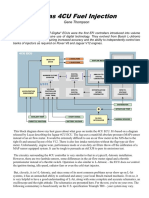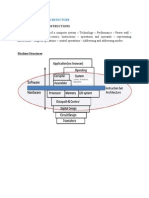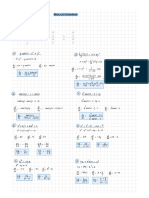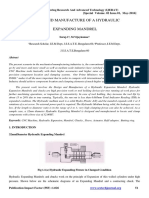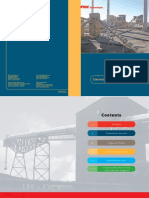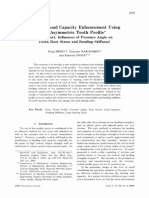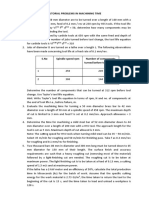Assemble System Unit (Manual) :: Proper Assembling Procedure
Uploaded by
olivirus1007Assemble System Unit (Manual) :: Proper Assembling Procedure
Uploaded by
olivirus1007Assemble System Unit (manual):
PROPER ASSEMBLING PROCEDURE: 1. Prepare the computer case (install power supply, I/O shield and spacers). 2. Install the drives (DVD, loppy and !DD). ". Install the CPU, fan, heat sink and memory module on the motherboard. #. Install the mother$oard into the casin% and e&pansion cards. '. Install the ca$lin%s (power connectors, (DD connector, ID)/*+,+ connector, -*. headers and system panel header). /. +ttach the monitor, 0ey$oard, mouse and plu% into a power source. 1. ,rou$leshoot i necessary. 2. +ssem$le and install networ0 connection.
Install Ope atin! Systems (OS" #P$%&' (ual b))t)' De*i+e D i*e s' LAN Cable (manual),
)&tensive procedures on dual/triple $oot operatin% systems (O*) installation can $e ound on this site http3//homepa%e.ntlworld.com/mosaddi4ue/. ,he type o operatin% systems to $e installed mi%ht chan%e overtime. (or 5+6 ca$le color codin%, memori7e the pairin%s $elow3
C)n-i!u e an( P int (manual):
1. 2. 3. 4. '. ). Click on the Start menu, then click on Control Panel When the Control Panel window opens you will see items in either Category View (continue with step #3) or Classic View (skip to item #4) ind and dou!le"click on the Network and Internet Connection icon. #e$t, %ind and dou!le"click on the Network Connections icon, a window will open with all network connections a&aila!le on the computer (wired and wireless) ind the network connection you want to manually con%i(ure, ri(ht"click on it and select Properties %rom the pop"up menu *n the Connection Properties window, under the section la!eled This connection uses the following items: %ind the Internet Protocol (TCP/IP) item and dou!le"click it. 1
+. -. /. 10. 11.
, new window will open, select the second radio !utton which is la!eled Use the following IP address .nter the appropriate *P address (1/2.1)-.0.1)1 su!net mask (usually 2''.2''.2''.0)1 and (ateway (the router or pro$y ser&er address) 2he ne$t part o% the windows will now ha&e a radio !utton selected which is la!eled Use the following DNS server addresses *% you need to access the *nternet, enter the 3#4 addresses pro&ided !y your *4P1 i% you do not ha&e that in%ormation you can use the 5pen3#4 ser&er. 2heir 3#4 addresses are6 208.67.222.222 and 208.67.220.220 ,%ter enterin( the re7uired in%ormation, click the 58 !utton twice and close the Control Panel window.
C.an!in! /) 0! )up an( C)mpute Name " 4tart 9 4ettin(s 9 Control Panel 9 4ystem 9 Computer #ame 2a! 9 Chan(e 2a! 92ype #ew Computer #ame and Work(roup 9 58..58..58..:estart Installing Network Printer 4tart 9 4ettin(s 9 Control Panel 9 Printers and a$es 9 ,dd Printer (Printers 2asks) 9 (,dd Printer Wi;ard) #e$t 9 4elect <, #etwork Printer, or =..> 9 #e$t 9 ?rowse Printer 9 #e$t 9 4elect *nstalled #etwork Printer 9 #e$t 9@es.. inishA Note: Turn-off your firewall efore installing networ! "rinter# !ile/!older 4harin( " :i(ht"Click older to 4hare 9 Properties 9 4harin( 2a! 9 #etwork 4harin( and 4ecurity (Click <*% you understand the security :isk=.>) 9 Bust .na!le 4harin( 9 58 9 4elect 4hare this %older on the network 9 58 S"aring Printer 4tart 9 4ettin(s 9 Control Panel 9 Printers and a$es 9 :i(ht"click *nstalled Printer 9 4harin( 9 4hare this Printer958
central processing #nit (CP$) " *nterprets and carries out !asic instructions that operate a computer %eat sinkCcomponent with %ins that cools processor rando& access &e&or' (()*) " Demory chips that can !e read %rom and written to !y processor. ,lso called main memory or primary stora(e. Dost :,D is &olatile, it is lost when computerEs power is turned o%%. read onl' &e&or' ((+*) " Demory chips that store permanent data and instructions. #on&olatile memory, it is not lost when computerEs power is turned o%%. ,asic inp#t and o#tp#t s'ste& (-I+S) " the %irst pro(ram to run when you turn on your computer. *t is stored in a :5D chip on the mother!oard. co&ple&entar' &etal o.ide se&icond#ctor &e&or' (C*+S ) " 4tores date, time, and computerEs startup in%ormation. Daintained !y a small !attery a%ter you turn the computer o%%. adapter card " .nhances system unit or pro&ides connections to e$ternal de&ices called peripherals. ,lso called an e$pansion card. e.pansion slot " ,n openin(, or socket, on the mother!oard that can hold an adapter card Port connects e$ternal de&ices to system unit Connector Foins ca!le to peripheral /esktop Co&p#ter Cases 3esktop computer cases are the home to all the computer components. .&erythin( includin( the mother!oard, the hard dri&e, the cd dri&e, the %loppy dri&e and the power supply (o inside a computer case. Computer cases can !e di%%erent colors and in recent years some ha&e !ecome %ancy. .$tras, such as %ront G4? ha&e !ecome popular as well. *ot"er,oards Computer Dother!oards are essential to a computer. ,ll the computer components somehow connect to the mother!oard. 2he Power 4upply powers up the mother!oard and the CPG is laid inside the mother!oard. 2he memory is also put into the mother!oard. Hard 3ri&es, loppy 3ri&es and C3I3J3 players all connect to the mother!oard usin( either the *3. :i!!on ca!le or the later 4,2, ca!les. 2hus a mother!oard is &ery important %or it connectsall the computer hardware components to(ether. Central Processing $nit (CP$) When e$plainin( the CPG (Central Processin( unit) to my in7uisiti&e youn(er !rothers * tell them that the CPG is the K!rainK o% a computer. *t is ar(ua!ly the most important piece o% hardware and when lookin( to !uy or !uild your own computer make sure you choose the correct CPG %or your needs. CPG clock speed is measured in hert;. *n pre&ious years it was me(ahert; (one million cycles per second) and now they are mainly measured in (i(ahert; (one !illion cycles per second). CPGs are most commonly manu%actured !y *ntel and ,D3. Co&p#ter *e&or'(CP$) :,D (:andom ,ccess Demory) or Computer Demory is another &ery important component to a computer. Computer Demory is a &olatile stora(e de&ice meanin( that when the computer is switched o%% e&erythin( stored on this temporary stora(e de&ice will !e lost. 2he more computer memory, the !etter the computer will run and the !etter it will handle pro(rams and so%tware. 3
:,D is now (enerally measured in Dh;, and most commonly seen in the types o% 43:,D, 33::,D, 33:2:,D. %ard /ri0e , Hard 3isk 3ri&e is another &ery crucial component to a computer. 2he hard dri&e is a permanent stora(e de&ice. *t is possi!le %or a computer to %unction without a Hard 3isk 3ri&e, !ut it would ha&e no operatin( system and would !e o% &ery little use. ,ll the in%ormation on your computer includin( the operatin( system (e(. windows LP), pro(rams and %iles will !e stored on the Hard 3ri&e. Hard 3ri&es are measured in Mi(a!ytes (one !illion !ytes). C///1/ /ri0es C3I3J3 3ri&es are another stora(e de&ice in a computer. C3 3ri&es are used to read C3Ks with in%ormation on them such as an operatin( system, pro(rams or data %iles. :ecently C3":W and 3J3":W ha&e !een included in computers meanin( that it is possi!le to write data to !lank disks. C3 3ri&es are measured !y their read and write speeds. 1ideo Cards , &ideo card is another compulsory component in a computer. 2he in%ormation (oes into the &ideo card and then is transmitted to the monitor where the in%ormation is displayed. 4ome mother!oards ha&e the (raphics card !uilt in, !ut the maFority need a seperate card that plu(s into the mother!oard. So#nd Card , sound card is another e$tra that can !e added to your computer. , sound card translates si(nals into sounds that can !e played !ack throu(h speakers. Dany mother!oards ha&e a sound card incorporated in the mother!oard, !ut %or those that donKt it is possi!le to (et one. *onitors Computer monitors are another compulsory unit o% a computer system. *t is possi!le %or the computer to %unction correctly without a monitor !ut there would !e &ery little point as you cannot see anythin(. 2he computer monitor connects to the (raphics card and it displays a picture on the screen. Computer monitors come in two types6 C:2 (Cathode :ay 2u!e) which are !lock monitors and NC3 (Ni7uid Crystal 3isplay) which are &ery thin. Network Card , Computer #etwork Card or a N,# (Nocal ,rea #etwork) card is increasin(ly !ecomin( more and more necessary in world o% !road!and internet and home networkin(. N,# ports are o%ten incorporated on the mother!oard and it is used %or networkin( computers to(ether or %or connectin( throu(h a router to the 8orld 8ide 8e$. 2ood l#ck3 4)
2erminolo(y
1. (DD connector 9 (loppy Dis0 Drive 2. ID) connector ( Inte%rated Drive )lectronics) 9 +n ID) connector is used to connect a :D9;O< drive or hard drive to a mother$oard, with a lon% and lat ri$$on ca$le. <ost mother$oards have two ID) connectors, which allow two drives to $e attached to each connector. One drive is set to master and the other drive is set to slave $y usin% a =umper that is normally located on the $ac0 o the drive. ,his allows a total o our ID) devices, (or drives), to $e attached to a typical computer. ". *+,+ connector (*erial +dvanced ,echnolo%y +ttachment) 9 is a computer !us inter%ace %or connectin( host !us adapters to mass stora(e de&ices such as hard disk dri&es and optical dri&es. 4erial ,2, was desi(ned to replace the older parallel ,2, (P,2,) standard (o%ten called !y the old name *3.), o%%erin( se&eral ad&anta(es o&er the older inter%ace6 reduced ca!le si;e and cost (+ conductors instead o% 40), nati&e hot swappin(, %aster data trans%er throu(h hi(her si(nallin( rates, and more e%%icient trans%er throu(h an (optional) *I5 7ueuin( protocol. 9 4,2, host"adapters and de&ices communicate &ia a hi(h"speed serial ca!le o&er two pairs o% conductors. *n contrast, parallel ,2, (the redesi(nation %or the le(acy ,2, speci%ications) used a 1)"!it wide data !us with many additional support and control si(nals, all operatin( at much lower %re7uency. 2o ensure !ackward compati!ility with le(acy ,2, so%tware and applications, 4,2, uses the same !asic ,2, and ,2,P* command"set as le(acy ,2, de&ices. #. DD; (Dou$le Data ;ate) 9 which means data tra&els at twice the clock rate. 33: is re%errin( to :,D or :andom ,ccess Demory and the connector is the socket into which you install :,D. '. VI+ 6O;,!.;ID>) 9 #orth!rid(e is also called DCH, memory controller hu!, or *DC, inte(rated memory controller, in *ntel systems, ,D3, J*,, 4i4 and other mother!oard. *t is common 4
separate the chipset into the north!rid(e and south!rid(e, althou(h there are rare instances where these two chips ha&e !een com!ined onto one die when desi(n comple$ity and %a!rication processes permit it. 2he #orth!rid(e is a controller chip used to deal with the interaction amon( the CPG, :,D, the N2 or Ne&el 2 cache, ?*54 :5D, and PC* .$press, and the ,MP, ,ccelerated Mraphics Port, which are the components that !ene%it most %rom %ast communication with the processor. *t uses the 4?, %ast ront 4ide ?us, to link the &arious components. 4ome north!rid(es also contain inte(rated &ideo controllers, also known as a MDCH, Mraphics and Demory Controller Hu!, in *ntel systems. ?ecause di%%erent processors and :,D re7uire di%%erent si(nallin(, a north!rid(e will mainly work with only one or two classes o% CPGs and only one type o% :,D in (eneral. 2he north!rid(e is important %or how %ar a computer can !e o&erclocked, as its %re7uency is used as a !aseline %or the CPG to esta!lish its own operatin( %re7uency. 2his chipKs temperature will increase as processor speed !ecomes %aster and coolin( measures need to !e implemented. CPGs cannot !e o&erclocked in%initely, as di(ital circuits are limited !y physical %actors such as propa(ation delay which increases with operatin( temperature, there%ore most o&erclockin( applications ha&e so%tware limitations which limit the multiplier and e$ternal clock settin(.
/. VI+ *O-,!.;ID>) 9 2he south!rid(e, also called *CH, *I5 controller hu!, in *ntel systems, ,D3, J*,, 4i4 and other mother!oard, is a chip used to implement the OslowerO capa!ilities o% the mother!oard in a north!rid(eIsouth!rid(e chipset computer architecture. 2he south!rid(e is not directly connected to the CPG, which is di%%erent %rom that o% the north!rid(e and the north!rid(e ties the south!rid(e to the CPG. 2hrou(h the use o% controller inte(rated channel circuitry, the north!rid(e can directly link si(nals %rom the *I5 units to the CPG %or data control and access. 9 With the south!rid(e !ein( remo&ed %rom the CPG, it is o%ten used %or the slower de&ices on a typical microcomputer. , particular south!rid(e will o%ten work with se&eral di%%erent north!rid(es, !ut these two chips must work to(ether. 2here is no industry"wide standard %or interopera!ility !etween di%%erent core lo(ic chipset desi(ns. 2raditionally this inter%ace !etween north!rid(e and south!rid(e was simply the PC* !us, !ut since this created a per%ormance !ottleneck, most current chipsets use a di%%erent inter%ace with hi(her per%ormance. 2he 4outh!rid(e handles more !asic, slower, %orms o% *I5, such as serial ports, G4? ports, and *3.. 2he 4outh!rid(e is attached to the #orth!rid(eKs PC* !us.
#orth!rid(e and 4outh!rid(e are chipsets used to handle communications %unctions on most PC type mother!oards. 1. +,? Power :onnector (+dvanced ,echnolo%y e?tended) 9 2he ,2L speci%ication re7uires the power supply to produce three main outputs, P3.3 J, P' J and P12 J. Now"power Q12 J and ' J4? (stand!y) supplies are also re7uired. 2. 8O5 !eader (8a0e9on95+6) 9 is an .thernet computer networkin( standard that allows a computer to !e turned on or wo!en u" !y a network messa(e. @. :6; *lot (:ommunications and 6etwor0in% ;iser) 9 is a slot %ound on certain PC mother!oards and used %or speciali;ed networkin(, audio, and telephony e7uipment. , mother!oard manu%acturer can choose to pro&ide audio, networkin(, or modem %unctionality in any com!ination on a C#: card. C#: slots were once commonly %ound on Pentium 4"class mother!oards, !ut ha&e since !een phased out in %a&or o% on"!oard or em!edded components. 1A. P:I *lot (Peripheral :omponent Interconnect) 9 is a computer !us %or attachin( hardware de&ices in a computer. 2hese de&ices can take either the %orm o% an inte(rated circuit %itted onto the mother!oard itsel%, called a "lanar device in the PC* speci%ication, or an e$pansion card that %its into a slot. 11. +>P 2? *lot (+ccelerated >raphics Port) 9 is a hi(h"speed point"to"point channel %or attachin( a &ideo card to a computerKs mother!oard, primarily to assist in the acceleration o% 33 computer (raphics.
'
You might also like
- Cessna 340a - Cessna340-N-E Proc Short CKLST - Rev3 - 09 25-15 PDF100% (4)Cessna 340a - Cessna340-N-E Proc Short CKLST - Rev3 - 09 25-15 PDF2 pages
- System Unit & Input/ Output Devices & Secondary Storage100% (1)System Unit & Input/ Output Devices & Secondary Storage20 pages
- Unit I Overview & Instructions: Cs6303-Computer Architecture100% (1)Unit I Overview & Instructions: Cs6303-Computer Architecture16 pages
- A Brief History of Computers and NetworksNo ratings yetA Brief History of Computers and Networks4 pages
- Composite Materials and Technology: Chapter - 3 Fabrication of CompositesNo ratings yetComposite Materials and Technology: Chapter - 3 Fabrication of Composites25 pages
- Gear Motors: Achieving The Perfect Motor & Gearbox MatchNo ratings yetGear Motors: Achieving The Perfect Motor & Gearbox Match16 pages
- Design and Analysis of Connecting Rod With Catia & Ansys SoftwareNo ratings yetDesign and Analysis of Connecting Rod With Catia & Ansys Software27 pages
- Principal Stresses: Minor Principal Stress (Mpa)No ratings yetPrincipal Stresses: Minor Principal Stress (Mpa)7 pages
- Mechanical Properties For Stainless Steel FastenersNo ratings yetMechanical Properties For Stainless Steel Fasteners3 pages
- Non Preloaded Bolts - Property Class 8.8 Countersunk Bolts With S275 - Blue Book - Steel For LifeNo ratings yetNon Preloaded Bolts - Property Class 8.8 Countersunk Bolts With S275 - Blue Book - Steel For Life2 pages
- Captura de Pantalla 2023-05-21 A La(s) 11.52.41 P.M.No ratings yetCaptura de Pantalla 2023-05-21 A La(s) 11.52.41 P.M.4 pages
- Comparison of Anti-Loosening Characteristics of Various M14 Threaded FastenersNo ratings yetComparison of Anti-Loosening Characteristics of Various M14 Threaded Fasteners8 pages
- Analysis of Stress and Deflection of Spur Gear by Using New Analytical Method Based On Taguchi Method and Finite Element AnalysisNo ratings yetAnalysis of Stress and Deflection of Spur Gear by Using New Analytical Method Based On Taguchi Method and Finite Element Analysis7 pages
- Spur Gear Tooth Stress Analysis and Stress Reduction: V.Rajaprabakaran Mr.R.AshokrajNo ratings yetSpur Gear Tooth Stress Analysis and Stress Reduction: V.Rajaprabakaran Mr.R.Ashokraj11 pages
- Interchangeability List For Glandless Pumps 2014: Reference No.: 1110.9-12No ratings yetInterchangeability List For Glandless Pumps 2014: Reference No.: 1110.9-1276 pages
- Thomson Super Metric Ball Bushing Bearings SpecsheetNo ratings yetThomson Super Metric Ball Bushing Bearings Specsheet11 pages
- Analysis of Spur and Helical Gears: Prepared by Wayne Book Based On Norton, Machine Design and Mischke and ShigleyNo ratings yetAnalysis of Spur and Helical Gears: Prepared by Wayne Book Based On Norton, Machine Design and Mischke and Shigley33 pages
- Line Reactors Can Protect Motors and Reduce Power Line Distortion From VfdsNo ratings yetLine Reactors Can Protect Motors and Reduce Power Line Distortion From Vfds2 pages
- Domex 700 MC Hot Rolled, Extra High Strength, Cold Forming SteelNo ratings yetDomex 700 MC Hot Rolled, Extra High Strength, Cold Forming Steel2 pages
- Design and Manufacture of A Hydraulic ExNo ratings yetDesign and Manufacture of A Hydraulic Ex10 pages
- Design and Optimization of Drive Shaft With CompositeNo ratings yetDesign and Optimization of Drive Shaft With Composite31 pages
- UNIT-1 Introduction To Embedded Systems Two Mark Questions and AnswersNo ratings yetUNIT-1 Introduction To Embedded Systems Two Mark Questions and Answers30 pages
- A-09-02122 Widia ToolingSystems Complete enNo ratings yetA-09-02122 Widia ToolingSystems Complete en1,190 pages
- Engineer's Handbook General Part: Torque Specification For Bolted ConnectionsNo ratings yetEngineer's Handbook General Part: Torque Specification For Bolted Connections2 pages
- Structural Analysis of Multi-Plate ClutchNo ratings yetStructural Analysis of Multi-Plate Clutch5 pages
- Design and Fabrication of Fixture For Labyrinth RingNo ratings yetDesign and Fabrication of Fixture For Labyrinth Ring6 pages
- Rotor Dynamics of Aircraft Gas Turbine EnginesNo ratings yetRotor Dynamics of Aircraft Gas Turbine Engines5 pages
- Relay Guide For Automotive - 20140506 - 0006No ratings yetRelay Guide For Automotive - 20140506 - 00061 page
- Spreadsheet Concepts Using Microsoft Excel: ObjectivesNo ratings yetSpreadsheet Concepts Using Microsoft Excel: Objectives26 pages
- Lab 8 CHM130LL Identification of Cations and AnionsNo ratings yetLab 8 CHM130LL Identification of Cations and Anions6 pages
- Sathyabama Institute of Science and Technology: IndexNo ratings yetSathyabama Institute of Science and Technology: Index39 pages
- A Guidebook To Mechanism in Organic Chemistry100% (1)A Guidebook To Mechanism in Organic Chemistry280 pages
- Program Structure of CNC Machines According To PALNo ratings yetProgram Structure of CNC Machines According To PAL16 pages
- Dupont Personal Protection Instruction Manual For Universal Pressure Test Kit No. 990810No ratings yetDupont Personal Protection Instruction Manual For Universal Pressure Test Kit No. 99081012 pages
- Cessna 340a - Cessna340-N-E Proc Short CKLST - Rev3 - 09 25-15 PDFCessna 340a - Cessna340-N-E Proc Short CKLST - Rev3 - 09 25-15 PDF
- System Unit & Input/ Output Devices & Secondary StorageSystem Unit & Input/ Output Devices & Secondary Storage
- Unit I Overview & Instructions: Cs6303-Computer ArchitectureUnit I Overview & Instructions: Cs6303-Computer Architecture
- Composite Materials and Technology: Chapter - 3 Fabrication of CompositesComposite Materials and Technology: Chapter - 3 Fabrication of Composites
- Gear Motors: Achieving The Perfect Motor & Gearbox MatchGear Motors: Achieving The Perfect Motor & Gearbox Match
- Design and Analysis of Connecting Rod With Catia & Ansys SoftwareDesign and Analysis of Connecting Rod With Catia & Ansys Software
- Mechanical Properties For Stainless Steel FastenersMechanical Properties For Stainless Steel Fasteners
- Non Preloaded Bolts - Property Class 8.8 Countersunk Bolts With S275 - Blue Book - Steel For LifeNon Preloaded Bolts - Property Class 8.8 Countersunk Bolts With S275 - Blue Book - Steel For Life
- Captura de Pantalla 2023-05-21 A La(s) 11.52.41 P.M.Captura de Pantalla 2023-05-21 A La(s) 11.52.41 P.M.
- Comparison of Anti-Loosening Characteristics of Various M14 Threaded FastenersComparison of Anti-Loosening Characteristics of Various M14 Threaded Fasteners
- Analysis of Stress and Deflection of Spur Gear by Using New Analytical Method Based On Taguchi Method and Finite Element AnalysisAnalysis of Stress and Deflection of Spur Gear by Using New Analytical Method Based On Taguchi Method and Finite Element Analysis
- Spur Gear Tooth Stress Analysis and Stress Reduction: V.Rajaprabakaran Mr.R.AshokrajSpur Gear Tooth Stress Analysis and Stress Reduction: V.Rajaprabakaran Mr.R.Ashokraj
- Interchangeability List For Glandless Pumps 2014: Reference No.: 1110.9-12Interchangeability List For Glandless Pumps 2014: Reference No.: 1110.9-12
- Thomson Super Metric Ball Bushing Bearings SpecsheetThomson Super Metric Ball Bushing Bearings Specsheet
- Analysis of Spur and Helical Gears: Prepared by Wayne Book Based On Norton, Machine Design and Mischke and ShigleyAnalysis of Spur and Helical Gears: Prepared by Wayne Book Based On Norton, Machine Design and Mischke and Shigley
- Line Reactors Can Protect Motors and Reduce Power Line Distortion From VfdsLine Reactors Can Protect Motors and Reduce Power Line Distortion From Vfds
- Domex 700 MC Hot Rolled, Extra High Strength, Cold Forming SteelDomex 700 MC Hot Rolled, Extra High Strength, Cold Forming Steel
- Design and Optimization of Drive Shaft With CompositeDesign and Optimization of Drive Shaft With Composite
- UNIT-1 Introduction To Embedded Systems Two Mark Questions and AnswersUNIT-1 Introduction To Embedded Systems Two Mark Questions and Answers
- Engineer's Handbook General Part: Torque Specification For Bolted ConnectionsEngineer's Handbook General Part: Torque Specification For Bolted Connections
- Design and Fabrication of Fixture For Labyrinth RingDesign and Fabrication of Fixture For Labyrinth Ring
- Spreadsheet Concepts Using Microsoft Excel: ObjectivesSpreadsheet Concepts Using Microsoft Excel: Objectives
- Lab 8 CHM130LL Identification of Cations and AnionsLab 8 CHM130LL Identification of Cations and Anions
- Sathyabama Institute of Science and Technology: IndexSathyabama Institute of Science and Technology: Index
- Program Structure of CNC Machines According To PALProgram Structure of CNC Machines According To PAL
- Dupont Personal Protection Instruction Manual For Universal Pressure Test Kit No. 990810Dupont Personal Protection Instruction Manual For Universal Pressure Test Kit No. 990810


